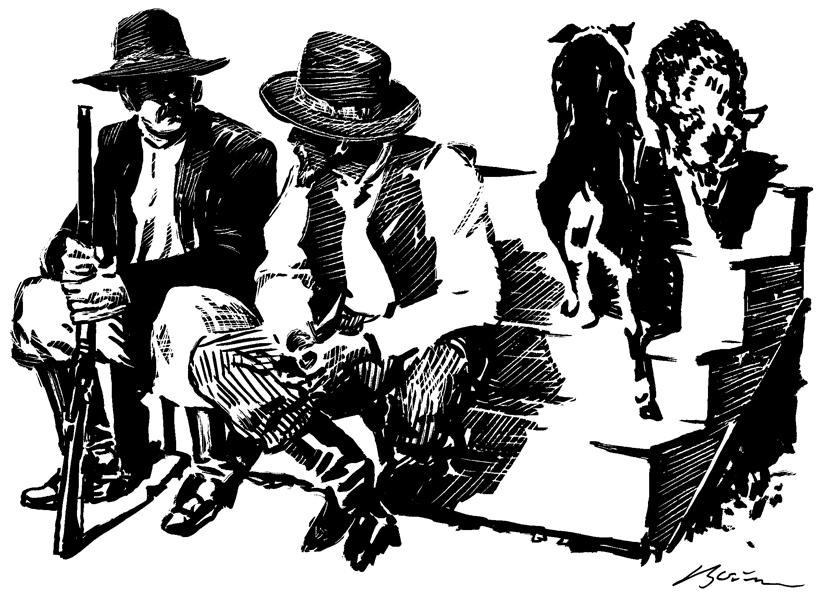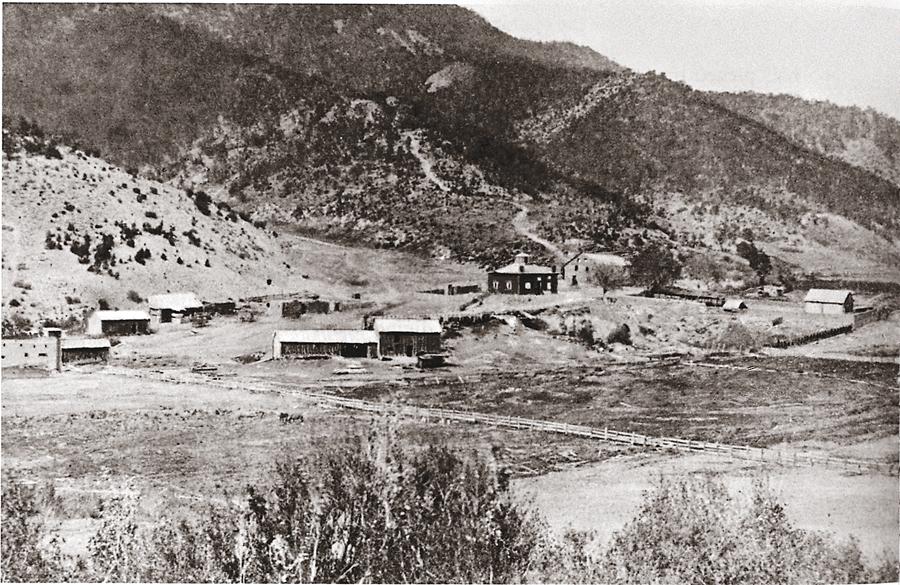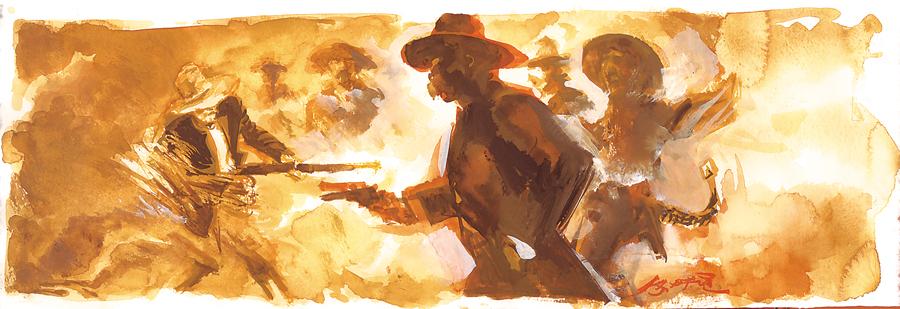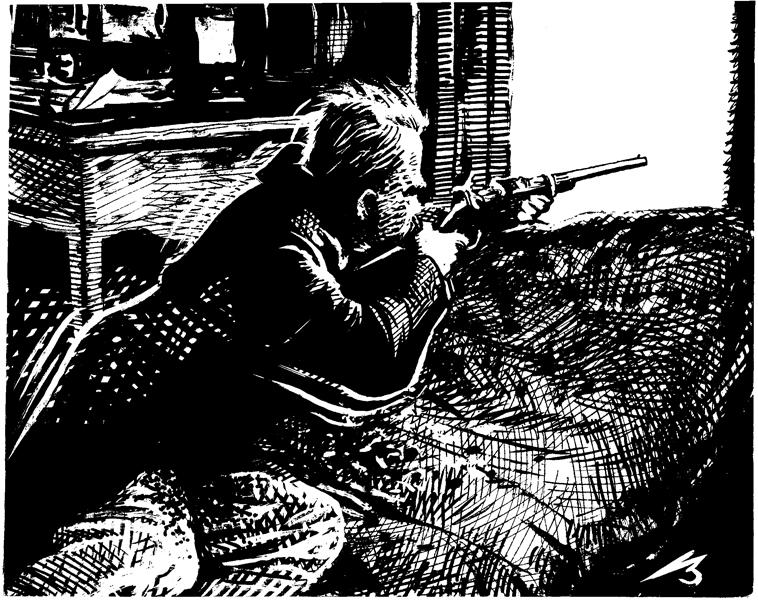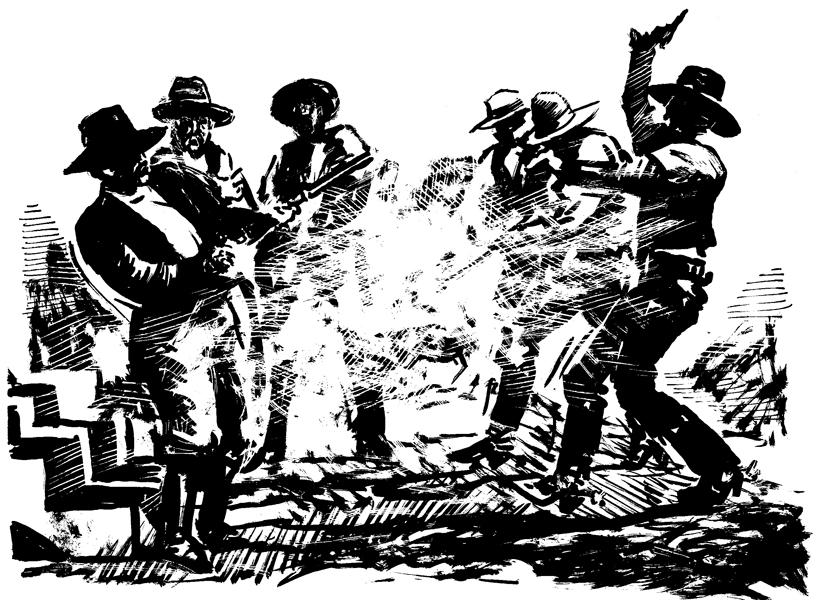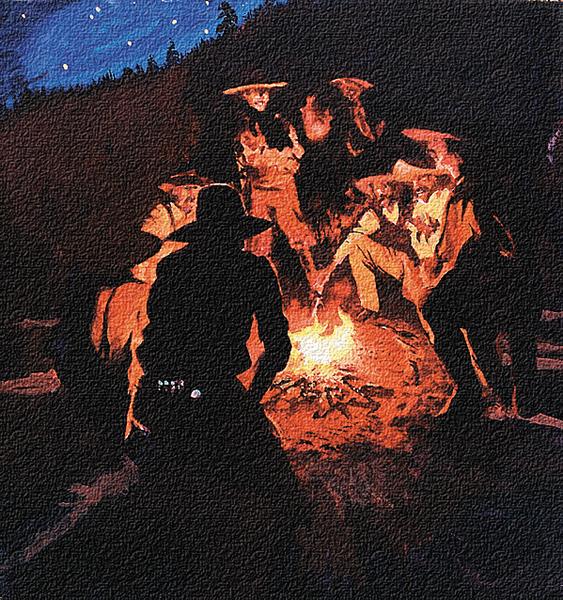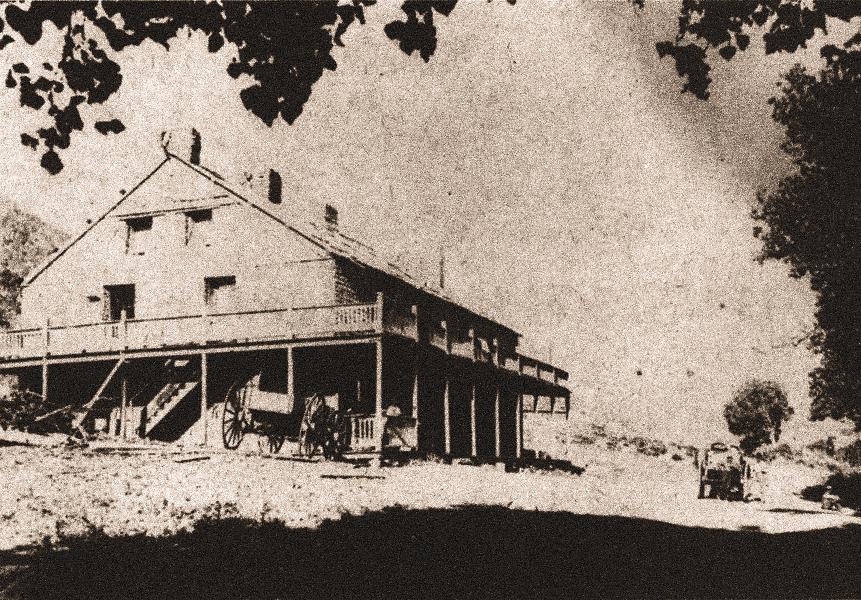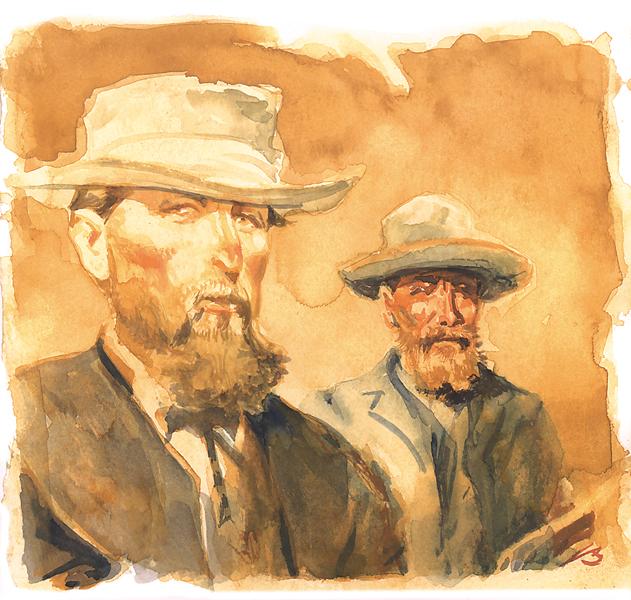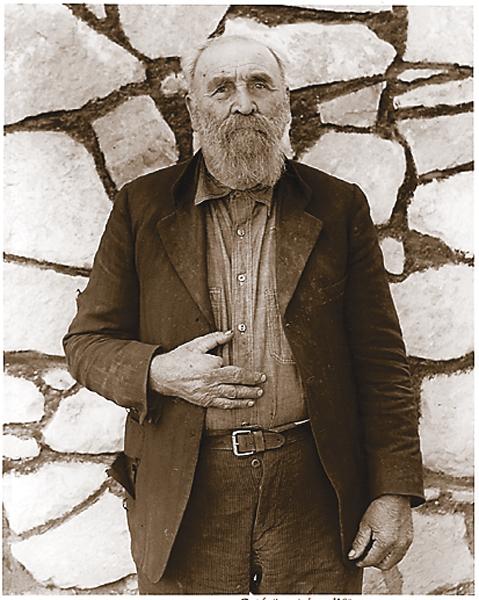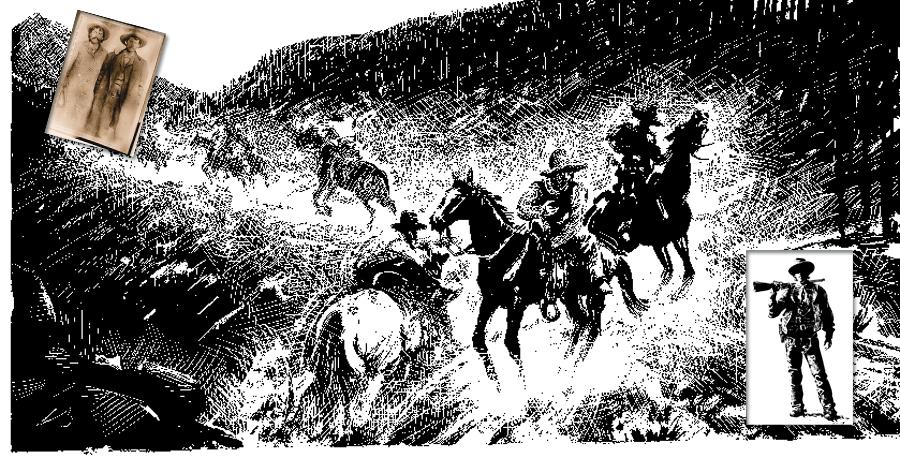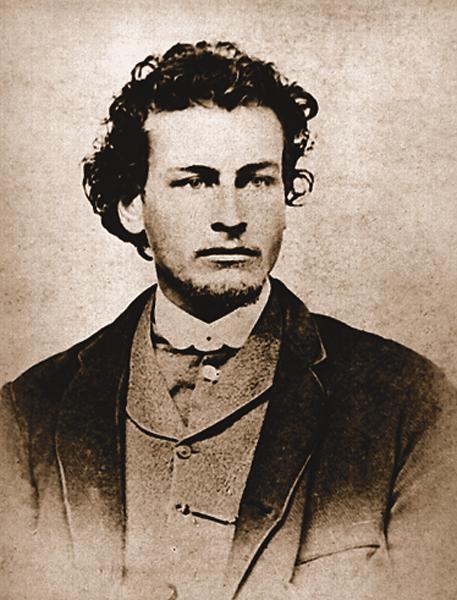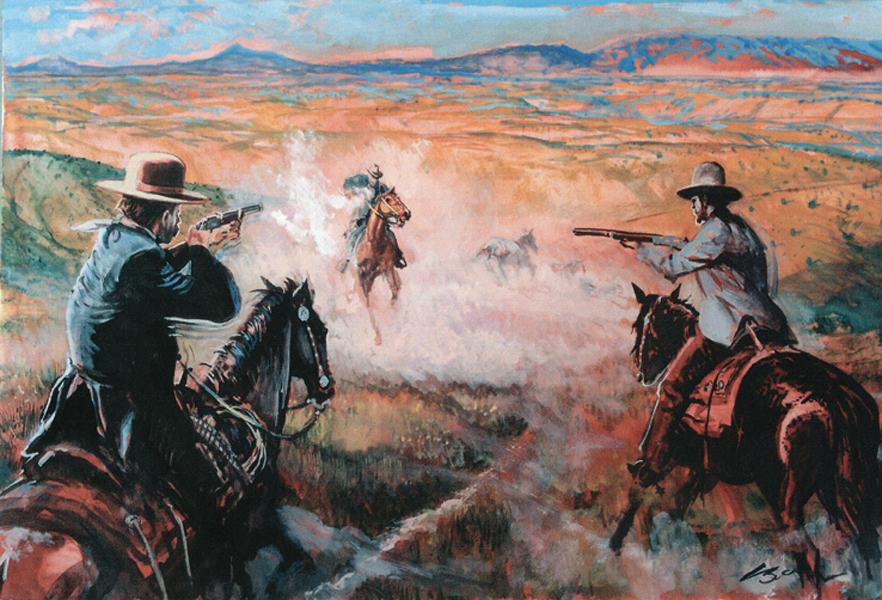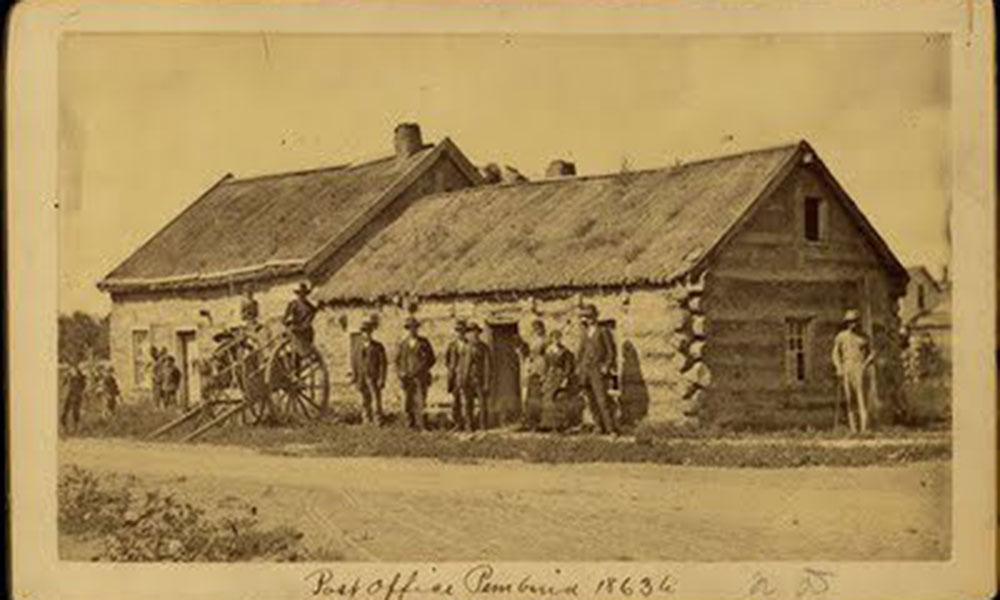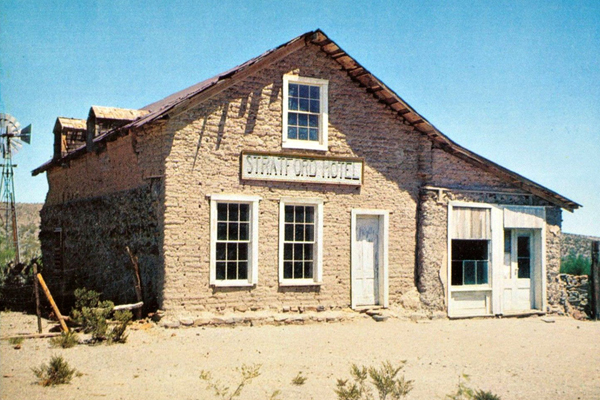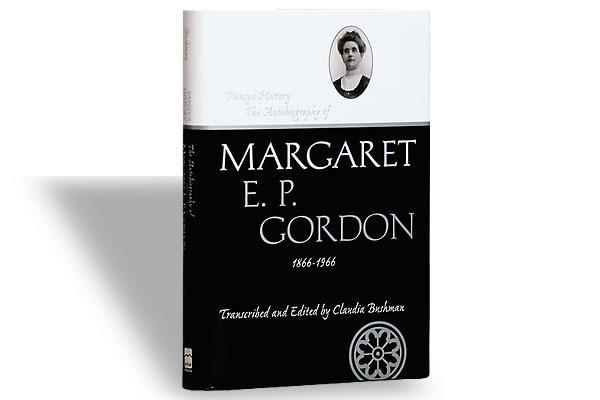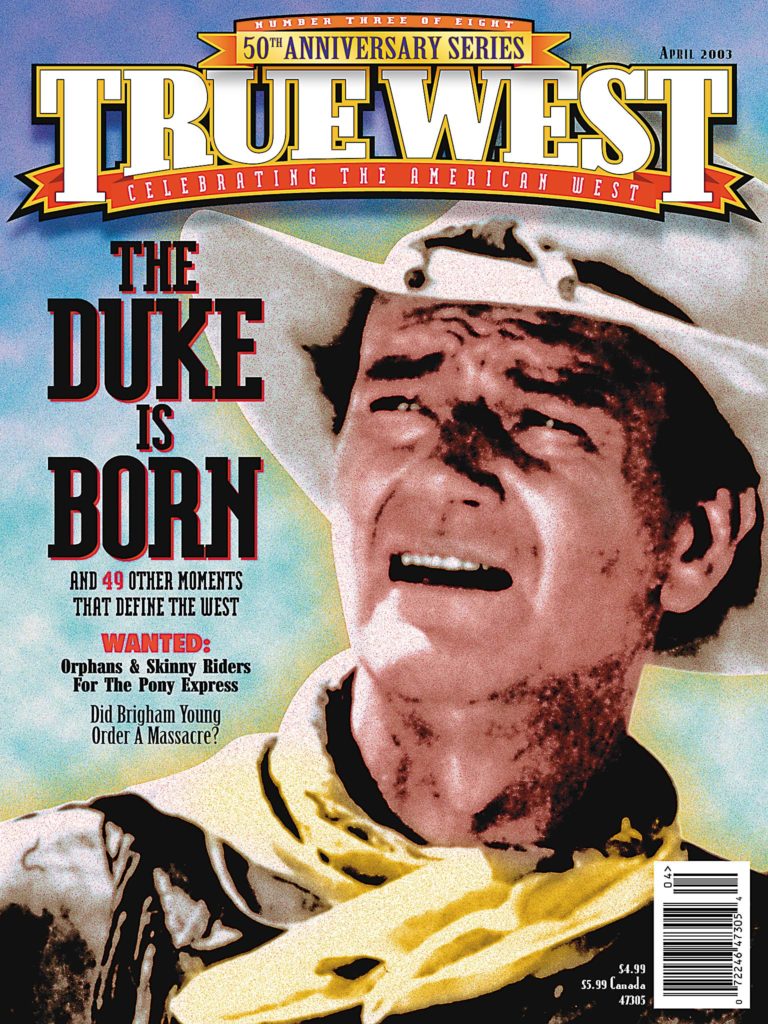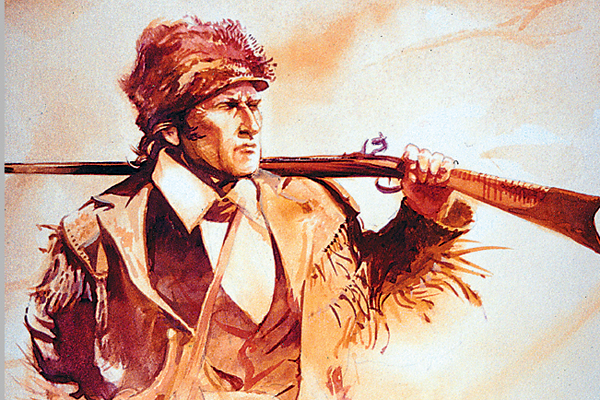
April 4, 1878
Riding 13-strong, the Regulators rein in at Blazer’s Mill on the Mescalero Apache reservation. After drawing the short straw, Regulator John Middleton stands lookout while the remaining bravos enter the Indian agency’s dining room and demand free meals. (The agency is leasing Dr. Blazer’s building for its office.)
Riding in from the South, “Buckshot” Roberts is unaware of the Regulators as he approaches Blazer’s Mill. He ties his packhorse to a tree and prods the “little mule” he’s riding into Tularosa Creek. Halfway across, his mount hits a hole and has to swim. As rider and mule come up the bank, both are wet “clear up over the saddle.”
New to the area, Middleton spots the soaked and “heavily armed man” approaching and watches him warily.
Roberts reins in at the corner of the agency’s office and tethers his mule. Leaving his gunbelt with its knife and pistol hanging over the saddle horn, he carries his .44 Winchester and goes into the post office, still oozing creek water. As Middleton eavesdrops on the stranger, he overhears the name Roberts. He then slips into the dining room and tells his captain, Richard Brewer, who responds, “I’ve got a warrant for him.”
Regulator Frank Coe comes outside to talk to Roberts—a friend and neighbor—about surrendering. The two walk to the west side of the building. Roberts asks Coe to go inside and look at a Las Cruces newspaper, claiming it will exonerate him from the warrant charges (see “Spark” sidebar, page 50). But Coe balks—“I saw some guns in the corner and there were some parties behind the door”— so the two sit on the stoop.
“We talked for half an hour,” Frank Coe later recalls. “I begged him to surrender, but the answer was ‘no, no, no.’ I think he was the bravest man I ever met—not a bit excited, knowing, too, that his life was in his hands.”
Worrying that Roberts could be using Coe as a hostage, Brewer asks for volunteers to end the stalemate. Chuck Bowdre steps forward, followed by John Middleton, Frank MacNab, Henry Brown, George Coe (Frank’s cousin), Doc Scurlock and Billy Bonney.
“We. . . bucked up, cocked our guns, and started around the house,” George Coe explains later. “Bowdre taking the lead. We took the dare, but we knew some of us were playing our last card. Roberts had his cocked rifle lying in his lap as he and Frank talked, and as Charlie Bowdre turned the corner of the house, he dropped his gun on Roberts and commanded him to throw up his hands.”
Rising to his feet, Roberts faces his adversaries and says cryptically, “Not much, Mary Ann.”
Roberts and Bowdre fire at the same time. Roberts’ first bullet hits Bowdre’s belt buckle and knocks his gunbelt to the ground. The same bullet then ricochets into George Coe’s gun hand, mangling his trigger finger and burrowing a groove down the barrel of his revolver.
Bowdre’s bullet hits Roberts just below the belly. Roberts staggers backwards, still firing rapidly. Frank Coe later remarks, “I never saw a man that could handle a Winchester as fast as he could.”
Roberts’ next bullet nails Middleton in the chest, just missing his heart. Another hits Doc Scurlock’s holstered pistol and courses down his leg. Billy Kid is “shaved” in the arm. (The “the” in Billy the Kid was added after the war.) Billy later claims, “it was too hot there for me.”
As Regulators stumble for cover, Roberts retreats into Dr. Blazer’s office, pulls a mattress off a bed and throws it in the doorway as a breastwork. Roberts’ Winchester is empty, so he grabs a single-shot 1873 officer’s model .45-70 Springfield rifle off the wall and takes up position behind the mattress.
With wounded men sprawled all around him, Brewer demands that Dr. Blazer and others bring Roberts out, but all of them decline the invitation.
Angrily, the Regulators’ leader vows to “have that man out” if he has to “pull the house down.” Brewer sprints down to a footbridge, crosses the creek and takes a position 150 yards—Frank Coe later says it was 125 steps—from the house (see map, page 51). Peering up behind a pile of logs, Brewer fires at Roberts but the bullet “just shaved the door facing,” as Frank Coe recounts later. After spotting the puff of smoke from Brewer’s gun, Roberts guesses the trajectory and waits for Brewer to take another peek. Seeing Brewer’s head poke up, Roberts lets loose with the big Springfield. The arcing lead slug hits Brewer’s left eye, leaving a tiny blue mark, before blowing out the back of his skull.
With three men severely wounded and their leader slain, the Regulators flee the battlefield, heading over the mountains for the Ruidoso Valley.
The Spark that Started the Lincoln County War
A precocious Englishman, John Henry Tunstall, 24, had big plans to usurp the Murphy-Dolan business interests in Lincoln County and hired Billy Kid and others to protect him. In spite of his hired guns, Tunstall was killed on February 18, 1878, by a rogue element of a sheriff’s posse (left). Many of the posse members were drafted by legitimate authorities who had no intention of killing the Englishman. It’s possible Buckshot Roberts was of this sentiment.
At Blazer’s Mill, Roberts tries to prove his innocence with a newspaper he wants to show Frank Coe, although that is supposition. Frank never looks at the paper, and Roberts’ name is on the arrest warrant that ultimately dooms him.
Buckshot Checks Out
Andrew L. Roberts is also known as Bill Williams. (The nickname “Buckshot” seems to have originated with Emerson Hough’s 1905 book The Story of The Outlaw, which contained a fictional account of the Blazer’s Mill fight. There is no earlier known reference to Roberts as Buckshot.) Roberts is selling his farm on the Ruidoso and stopped at the agency post office earlier, hoping to receive a check. Leaving empty-handed, he sees the mail buckboard approach Blazer’s Mill and returns. A small man, Roberts was in the posse that killed John Tunstall (see above sidebar), and because of it, Roberts’ name is on one of the warrants carried by Brewer. Somewhere on the frontier (Hough says Texas), Roberts received a shoulder wound and as a result can’t raise his arm above his waist. Interviewed in 1927, Frank Coe, who was a neighbor of Roberts, relates why his friend was so against surrendering to the Regulators: “The Kid is with you,” Frank quotes Roberts as saying, “and will kill me on sight.”
Odds & Ends
- Buckshot Roberts lived until noon the next day. To avoid digging two holes, the grave diggers buried Roberts and Brewer in the same grave. One eyewitness, Johnny Patten, claimed he couldn’t make a very good coffin, “so I built it in the shape of a big V, with no end piece at the foot” and put in both bodies.
- As George Coe writhed in pain, his hand wound was attended to by the post surgeon from Fort Stanton. Dr. Ealy of Lincoln later amputated the mangled trigger finger. George dipped his hand in carbolic acid periodically to help the healing process. He lived well into the 20th century and readily showed off his digit-shy hand.
- The Regulators continued their campaign against the Murphy-Dolan forces until July, when they were surrounded in Lincoln, but that’s another Classic Gunfight.
- Interviewed in 1991, one of the Blazer grandkids, then in his 80s, said family members often went hunting with the Springfield rifle that Roberts had used. But, he added with a chuckle, “None of us could hit a damn thing with that rifle.”
We recommend: Bob Boze Bell’s The Illustrated Life & Times of Billy the Kid and Frederick Nolan’s The West of Billy the Kid. Both books can be ordered at 888-687-1881. To read the correspondence between BBB and Fred Nolan, and see the incredible discrepancies between accounts of this fight, go to www.truewestmagazine.com and click on “The Mess at Blazer’s Mill.”
Photo Gallery
– University of Arizona Library special collection –
Andrew L. Roberts is also known as Bill Williams. (The nickname “Buckshot” seems to have originated with Emerson Hough’s 1905 book The Story of The Outlaw, which contained a fictional account of the Blazer’s Mill fight. There is no earlier known reference to Roberts as Buckshot.) Roberts is selling his farm on the Ruidoso and stopped at the agency post office earlier, hoping to receive a check. Leaving empty-handed, he sees the mail buckboard approach Blazer’s Mill and returns. A small man, Roberts was in the posse that killed John Tunstall (see above sidebar), and because of it, Roberts’ name is on one of the warrants carried by Brewer. Somewhere on the frontier (Hough says Texas), Roberts received a shoulder wound and as a result can’t raise his arm above his waist. Interviewed in 1927, Frank Coe, who was a neighbor of Roberts, relates why his friend was so against surrendering to the Regulators: “The Kid is with you,” Frank quotes Roberts as saying, “and will kill me on sight.”
– All illustrations by BBB –
– True West Archives –
– All photos on this page courtesy Robert McCubbin –
– Courtesy Fred Nolan –


